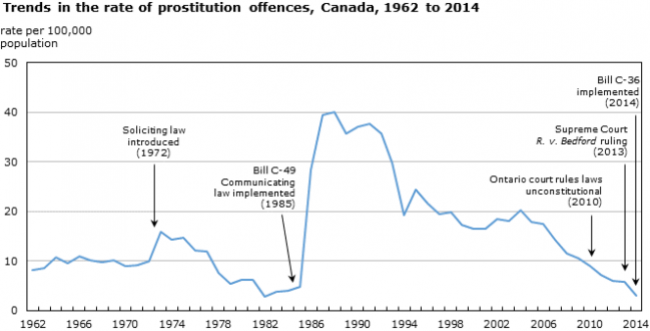The rate of prostitution-related incidents reported in 2014 was the lowest it’s been in decades, but the proportion of under-age people accused of prostitution offences went up, according to a new Statistics Canada report. The study examined trends in prostitution offences up until December 2014, when new legislation was passed to shift the focus of criminality from sex workers to clients.

WATCH: Fighting teen prostitution in Quebec

Police reported a rate of three prostitution-related incidents per 100,000 people, the lowest rate since 1982, and found that prostitution offence rates between 2009 and 2014 went down from 9.3 to 1.35 accused per 100,000 when averaged across genders.

However, the report also found that homicides of sex workers were more likely to remain unresolved compared to the general population, stating that “homicides involving victims who were sex workers may be more difficult to solve in part because they usually do not involve family members or accused who are otherwise well-known to the victims.”
Activist and former sex worker Katarina MacLeod agrees that this is often the case, but adds that authorities aren’t motivated to investigate the killings of sex workers.
READ MORE: Former federal Crown prosecutor facing charges related to a prostitute
“If the police want to investigate a murder, they can and people will be found,” she says. “But why put government money into investigating this kind of stuff when people see these girls as worthless? They’re seen as just being prostitutes, not human beings.”
MacLeod says she isn’t surprised at the finding that youth under 18 increasingly make up a bigger proportion of people accused of prostitution-related offences, up from 0.8 per cent in 2009 to two per cent in 2014.

“We’re now seeing 12, 13 and 14-year-old girls entering into this because they say they want a new phone, nice clothes and they think ‘I already have sex so I might as well be a prostitute’,” she says. “We see students pimping out other students in school. It’s become a social norm and a ‘cool’ thing for them to do but they don’t understand the long-term damage.”
The StatsCan report says future analyses will take into account statistics drawn from after the introduction of Bill C-36 in late 2014. But MacLeod says anecdotal evidence on the street suggests that police haven’t been targeting customers or “Johns” any more than before.
READ MORE: 10 N.B. men arrested for prostitution-related offences
“We don’t see these ‘John sweeps’ happening. The police have the means to go out and target the clients but they’re not doing it,” she says. “I work with a lot of police and they are more understanding that women are victims, but the sad reality is that we still don’t see them going out and targeting the clients. There’s still a lot of mistrust of police, and there are some police who are clientele.
“This isn’t the world’s oldest profession, it’s the oldest oppression.”
- Budget 2024 failed to spark ‘political reboot’ for Liberals, polling suggests
- Train goes up in flames while rolling through London, Ont. Here’s what we know
- Peel police chief met Sri Lankan officer a court says ‘participated’ in torture
- Wrong remains sent to ‘exhausted’ Canadian family after death on Cuba vacation




Comments